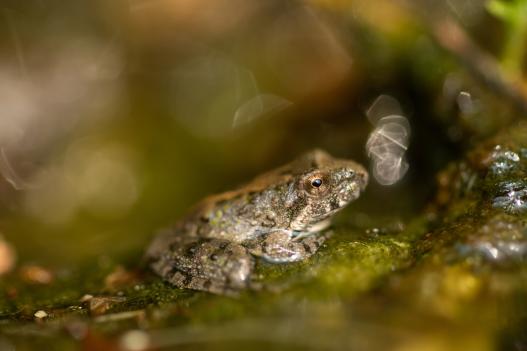January 2024 Edition | Volume 78, Issue 1
Published since 1946
The Wetlands of Nebraska Project
The Wetlands of Nebraska project highlights the importance of wetlands through videos and stories that take place across Nebraska’s diverse landscapes. This project was led by the U.S. Geological Survey Nebraska Cooperative Fish and Wildlife Research Unit, the Nebraska Game and Parks Commission, in collaboration with Platte Basin Timelapse, Ducks Unlimited, and the University of Nebraska–Lincoln (UNL).

Wetlands are critically important ecosystems. Many of Nebraska’s resident wildlife species such as the Blanchard’s cricket frog need wetlands for their survival.
Dakota Altman/Platte Basin Timelapse, copyright release form on file.
Wetlands are considered one of the most productive and biologically rich ecosystems in the world, supporting an array of plant and animal life and driving many important ecosystem functions. Wetlands are highly dynamic systems, ebbing and flowing from dry to wet periods in a matter of weeks, months, seasons, or even years. Wetlands have different meanings to different people, which can create divisions between how we feel about them and their value. Wetlands throughout history have been viewed as places of muck, mosquito-infested lagoons, where disease runs rampant, and in turn, must be drained and concreted over. Through science, our understanding of the important benefits that wetlands provide has grown. However, many people are not aware of these benefits, and this is a major reason that the Wetlands of Nebraska project was initiated.
Over the last 200 years, Nebraska experienced a 35% decrease in wetland acres from 2.9 million to 1.9 million. Even with this loss, Nebraska contains some form of wetland in each of its 93 counties.
There are four major types of wetlands in Nebraska including Riverine, Playa, Sandhills, and Saline/Alkaline. In addition, an urban wetland category was thought necessary to incorporate as many wetlands don’t fit into the other categories, such as the ones within our urban centers. These wetlands are dynamic and diverse and include everything from marshes, lake edges, river and stream edges, backwater sloughs, oxbows, wet meadows, fens, forested floodplains, salt flats, and freshwater seeps.
Wetlands perform functions such as flood control, carbon sequestration, erosion control, nutrient retention, and groundwater recharge. Wetlands are a great place for recreational activities like canoeing, fishing, waterfowl hunting, and hiking. Migratory and resident wildlife use wetlands as their stopover habitat, breeding grounds, and homes. Specialized and unique plant communities live only in these watery habitats. All these functions are vital to the survival of animals, plants, and humans alike.
Funding was provided through an Environmental Protection Agency (EPA) grant and matching funds were provided by Ducks Unlimited, UNL, and the Nebraska Game and Parks Commission. The project fulfilled the goals of advocating for wetlands and created outreach materials that will better help the public understand the beauty, diversity, and importance of Nebraska’s wetland resources. The products from this project include an updated Nebraska Wetlands guidebook, a student wetland activity booklet, educational material for schools, and a series of multimedia products, including five films and ESRI StoryMaps.
The Wetlands of Nebraska project took over three years to complete. It started conversations around wetlands and engaged the public through presentations to a variety of groups with diverse audiences throughout Nebraska and beyond. It even took the core team outside of the state to follow along the important migratory flight path of blue-winged teal from South Dakota’s prairie pothole region to the coastal marshes of Louisiana, emphasizing how important their stopover is in the wetlands of Nebraska.
The five films produced by Platte Basin Timelapse documented each wetland category showcasing a diversity of species, giving scale to interconnected landscapes, and hearing from people living and working among those wetlands. The films have garnered attention from many people, with a total of 8,124 views to date. An article in the May 2023 issue of the NEBRASKAland magazine featured this project. Additionally, five Environmental Systems Research Institute (ESRI) StoryMaps were created giving behind-the-scenes stories of what it is like to explore the various wetlands of Nebraska. The Wetlandology magazine was created for use in 4th-grade classrooms around the state, and a total of 34,000 copies were distributed. Access to information about wetlands will help students learn about these unique ecosystems right outside their door and showcase the conservation value wetlands have. The updated Guide to Nebraska’s Wetlands has been distributed to 18 different states and accessed through the online version by people from 17 different countries around the world. In early 2024, lesson plans on two key topics, animal engineers and wetland plant adaptations, were released on the Nebraska Game and Parks Wetlands of Nebraska website.
It will take a collective effort to raise awareness about Nebraska’s wetland resources through continued outreach. Most importantly, it will be imperative that we show the beauty of wetland ecosystems, so they can be protected and made available for future generations to enjoy.
Through these multimedia products, the collaborators hope to shift perspectives on what wetlands mean to the present and future. Creating awareness about why wetlands matter, and the conservation work being done to restore and conserve Nebraska’s wetlands is a huge part of why this project matters.
Ted LaGrange Nebraska’s Wetlands Program Manager who was part of the team that got this project underway stated that, “There was an important need to highlight the critical benefits that wetlands in Nebraska provide and to tell the stories of the people working to conserve these wetlands. The team working on this project, including the talented crew at Platte Basin Timelapse, did an outstanding job in addressing this need. The final products tell an amazing story that is worth checking out and will benefit wetland conservation well into the future.”
The ONB features articles from Cooperative Fish and Wildlife Research Units, U.S. Geological Survey. The Units are leading exciting, new fish and wildlife research projects that we believe our readers will appreciate reading about.
Dakota Altman (He/Him/His), daltman3@unl.edu, School of Natural Resources - University of Nebraska-Lincoln, and Producer, Instructor, Conservation Storyteller, Platte Basin Timelapse